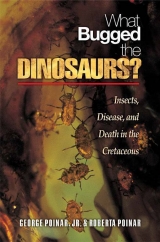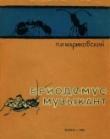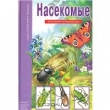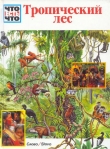
Текст книги "Кто кусал динозавров?"
Автор книги: Роберт Пойнар
Соавторы: мл. Джордж Пойнар
сообщить о нарушении
Текущая страница: 14 (всего у книги 17 страниц)
Приложение А
Меловые Hexapoda
Сведения из различных источников, главным образом из History of Insects35, дают информацию в общей сложности о 32 отрядах и 490 семействах. Пунктирная линия обозначает существование группы на протяжении всего мелового периода или его части. Буквы L, B и C относятся к находкам в ливанском, бирманском и канадском янтаре. Звёздочки означают вымершие группы. Поскольку постоянно обнаруживаются новые ископаемые остатки меловых насекомых, этот список неполон.
Приложение B
Ключевые факторы, способствующие выживаниюназемных животных
Характеристики, которые относятся к большинству представителей Hexapoda (шестиногих членистоногих), выделены курсивом. Характеристики, которые могут относиться к большинству динозавров, выделены жирным шрифтом. Конкретные группы должны классифицироваться независимо друг от друга (поскольку существуют исключения). Чем большим числом положительных особенностей обладает группа, тем меньше вероятность её вымирания. r = признак использования r-стратегии; K = признак использования K-стратегии.
Факторы
Положительныеособенности
Отрицательные особенности
Группа
Полифилетическая
Монофилетическая
Приспособления, связанные с воспроизводством
Темп размножения
Высокий (r)
Низкий (K)
Начало размножения
Раннее (r)
Позднее (K)
Время жизни поколения
Короткое
Долгое
Выводки в течение года
Многочисленные (мультивольтинный тип)
Один (унивольтинный тип)
Количество репродуктивных циклов в течение жизни
Много
Один
Количество потомства в течение жизни
Много (r)
Мало (K)
Соотношение размеров новорождённой и взрослой особей
Больше
Меньше
Темп роста
Быстрый (r)
Медленный (K)
Выживаемость потомства
Высокая
Низкая
Рождение молодняка
Синхронное
Несинхронное
Забота о потомстве
Нет (r)
Имеется (K)
Выбор брачного партнёра
Полигамия
Моногамия
Тип размножения
Аутбридинг (экзогамия)
Инбридинг (эндогамия)
Места размножения
Многочисленные
Жёстко закреплённые, ограниченные по количеству или специализированные
Факторы
Положительные особенности
Отрицательные особенности
Характеристики взрослых особей
Размер тела
Маленький (r)
Большой (K)
Размер популяции
Большой
Малый
Биологическое разнообразие
Высокое
Низкое
Распространение
Всесветное
Эндемичное
Типы местообитаний
Разнообразные (эвритопный вид)
Ограниченные (стенотопный вид)
Окружающая среда
Непредсказуемая (r)
Стабильная (K)
Способность к адаптации
Хорошая (пластичные формы) (r)
Слабая (K)
Расселение
Чрезвычайно подвижный (r)
Ограниченно способный к расселению (K)
Характеристики миграции
Отсутствуют или разнообразные
Жёстко установленные, неизменные
Социальное поведение
Одиночный
Общественный
Тип питания
Универсал
Специализированный
Трофический уровень
Первичный
Высокий
Продолжительность жизни
Короткая
Большая
Смертность
Независима от плотности поселения (r)
Связана с плотностью поселения (K)
Ресурсы окружающей среды
Редко бывают ограниченными (r)
Зачастую ограниченные (K)
Сопротивляемость токсинам
Высокая
Низкая
Темп появления мутаций
Высокий
Низкий
Сезонная активность
Покоящиеся стадии
Круглогодичная активность
Температурная устойчивость
Широкая
Ограниченная
Риск хищничества
Низкий
Высокий
Темп обмена веществ
Низкий
Высокий
Температура тела
Холоднокровное
Теплокровное
Приложение C
Проблемы, возникающие при оценке летописиокаменелостей и вымирания
A. Совокупность данных слишком мала.
1. Летопись окаменелостей неполна. Подавляющее большинство организмов прошлых эпох в биосфере сохранялось редко.2. Процесс фоссилизации – избирательный, благоприятствующий некоторым обстоятельствам и средам обитания. Включения в янтарь не репрезентативны в том плане, что при их образовании отбирались мелкие организмы, типичные места обитания которых были связаны со смолоносными деревьями. Замещённые минералом окаменелости образуются в таких местах, где их мог покрыть осадок. Большие кости сохранятся с большей вероятностью, чем маленькие. Организмы с твёрдыми образованиями вроде раковин и зубов представлены чаще, чем мягкотелые существа.3. Летопись окаменелостей не является непрерывной, образует большие пробелы, и результатом этих обстоятельств часто бывает внезапное появление групп организмов, ранее считавшихся вымершими (эффект Лазаря). В настоящее время известно очень мало местонахождений, охватывающих по времени мел-палеогеновую границу, и даже они прерывисты.4. В местонахождениях окаменелостей отсутствие организма не означает, что его не существовало. Присутствие же ископаемых остатков говорит вам не больше, чем то, что данная группа существовала в конкретное время в конкретном месте. Единственная окаменелость не даёт нам никакой информации о распространении группы в мире, о том, насколько долго она существовала, или когда она вымерла. Явное отсутствие в одном местонахождении не исключает выживания в другом месте. Соответственно, имея на руках отрицательные данные, давать оценку явлениям вымирания невозможно.5. Меловые местонахождения окаменелостей не распределены равномерно, и потому выяснение характера тенденций для различных групп в масштабе всего мира очень сложно.
6. Редкий вид может быть вообще не представлен в некоторых местонахождениях, но это не означает, что его не было.
B. Данные могут быть некорректными.
1. Датировка окаменелостей зачастую ведётся косвенным путём, и потому их возраст и фактическое время некоторых событий вымирания могут быть ошибочными.2. Много окаменелостей подвергается перезахоронению из более древних слоёв в более молодых отложениях, таким образом запутывая летопись (эффект зомби).3. Существует некоторая неуверенность в идентификации видов/родов, поскольку большинство окаменелостей фрагментарно и диагностические признаки сглажены или отсутствуют. Также среди таксонов различных организмов существуют нестыковки из области систематики.4. По мере того, как вы приближаетесь к границам событий вымирания, объём пород, доступных для взятия образцов, часто сужается, уменьшая тем самым возможности обнаружения определённой окаменелости (эффект Синьора-Липпса).
C. Человеческие факторы.
1. Предвзятости, срабатывающие при идентификации окаменелостей и оценке событий вымирания, могут оказаться сильными, и при таком небольшим массиве данных интерпретация может мотивироваться предубеждением.2. Поскольку не существует безотлагательной необходимости в разрешении проблемы мел-палеогеновых вымираний, усилия следует направить скорее на определение того, были ли вымирания различных групп внезапными или постепенными, нежели на подтверждение их причины.
D. Трудности, присущие науке.
1. Интерпретация окаменелостей основывается на выводах, собранных из научных знаний, представляющих лишь несколько сотен лет опыта человечества. Существует вероятность возникновения ошибок, потому что массив данных, имеющийся в нашем распоряжении на текущий момент времени, может быть искажённым и наверняка неполным.2. Предсказание причин и последствий вымираний, которые происходят в наше время, зачастую является невозможным. Перенос предсказаний на время 65 млн. лет назад – ещё более проблематичен.3. Кажущееся на первый взгляд небольшим экологическое изменение вроде небольшого глобального потепления или похолодания могло иметь далеко идущие биологические последствия – как местные, так и в масштабах всего земного шара, тогда как драматическое событие вроде удара метеорита может быть значительно менее важным из-за непредсказуемости его последствий.4. Вымирания могут быть случайными, но случайные события могут происходить сериями.5. Виды могут обладать различной степенью важности в биологических системах. Вымирание ключевого вида может вызвать каскадный эффект и привести к вторичным вымираниям, которые являются прямым следствием изначального вымирания, но не связаны с его причиной.6. Время существования видов различно. Виды с коротким сроком существования, которые, возможно, уже вымирали при нормальных обстоятельствах, нельзя отличить от тех, которые, возможно, выживали бы ещё дольше, если бы не произошло события вымирания. Эти недолго существующие виды искажают интерпретацию вымираний.
Ссылки
1. Resh, V. H. & Cardé, R. T. 2003. Insecta. Overview, pp. 564–566 in Encyclopedia of Insects, Resh, V. H. & R. T. Cardé (eds.). Academic Press, Amsterdam.2. Boucot, A. 1990. Evolutionary Paleobiology of Behavior and Coevolution. Elsevier, Amsterdam, 725 pp.3. Blaxter, M., Dorris, M. & De Ley, P. 2000. Patterns and processes in the evolution of animal parasitic nematodes. Nematology 2: 43–55.4. Strong, D. R., Lawton, J. H. & Southwood, T. R. E. 1984. Insects on Plants: Community Patterns and Mechanisms. Harvard University Press, Cambridge, MA., 313 pp.5. Labandeira, C. C. 2002. The history of associations between plants and animals. pp. 26–74 in Plant-Animal Interactions, Herrera, C. M. & Pellmyr, O. (eds.). Blackwell Science, Oxford.6. Gradstein, F. M., Ogg, J. G. & Smith, A. G. (eds.). 2004. AGeologic Time Scale. Cambridge University Press, Cambridge, 589 pp.7. Russell, D. A. 2000. The mass extinctions of the Late Mesozoic. pp. 370–380 in The Scientific American Book of Dinosaurs, Gregory, P. S., (ed.). St. Martin’s Griffin, New York.8. Webster, D. 1999. A dinosaur named Sue. National Geographic Magazine 195: 46–60.9. Smith, A. G., Smith, D. G. & Funnel, B. M. 1994. Atlas of Mesozoic and Cenozoic Coastlines. Cambridge University Press, Cambridge, 99 pp.10. Vakhrameev, V. A. 1988. Jurassic and Cretaceous Floras and Climates of the Earth. Cambridge University Press, Cambridge, 318 pp.11. Azar, D. 2000. Les Ambres Mésozoïques du Liban. Ph.D. thesis, Univeristé de Paris, 164 pp.12. Edwards, W. N. 1929. Lower Cretaceous plants from Syria and Transjordania. Annals and Magazine of Natural History 4: 394–405.
13. Poinar, Jr., G. O. & Milki, R. 2001. Lebanese Amber. Oregon State University Press, Corvallis, 96 pp.14. Davies, E. H. 2001. Palynological analysis of two Burmese amber samples. Unpublished report by Branta Biostratigraphy Ltd. for Leeward Capital Corp., 6 pp.15. Davies, E. H. 2001. Palynological analysis and age assignments of two Burmese amber sample sets. Unpublished report by Branta Biostratigraphy Ltd. for Leeward Capital Corp., 4 pp.16. Grimaldi, D. A., Engel, M. S. & Nascimbene, P. C. 2002. Fossiliferous Cretaceous amber from Myanmar (Burma). American Museum Novitates 3361, 71 pp.17. Poinar, Jr., G. O. 2004. Programinis burmitis gen. et sp. nov., and P. laminatus sp. nov., Early Cretaceous grass-like monocots in Burmese amber. Australian Systematic Botany 17: 497–504.18. Poinar, Jr., G. O. & Chambers, K. 2005. Palaeoanthella huangii gen. and sp. nov., an Early Cretaceous flower (Angiospermae) in Burmese amber. Sida 21: 2087–2092.19. Santiago-Blay, J. A., Anderson, S. R. & Buckley, R. T. 2005. Possible implications of two new angiosperm flowers from Burmese amber (Lower Cretaceous) for well-established and diversified insect-plant associations. Entomological News 116: 341–346.20. Zherikhin, V. V. & Ross, A. J. 2000. A review of the history, geology and age of Burmese amber (Burmite). Bulletin of the Natural History Museum, London (Geology) 56: 3–10.21. Braman, D. & Koppelhus, E. B. 2005. Campanian Palynomorphs. pp. 101–130 in Dinosaur Provincial Park, Currie, P. J. & Koppelhus, E. B. (eds.). Indiana University Press, Bloomington.22. Jarzen, D. M. 1982. Palynology of Dinosaur Provincial Park (Campanion) Alberta. Syllogeus 38: 1–69.23. Knowlton, F. H. 1905. Fossil plants of the Judith River beds. United States Geological Survey Bulletin 257:129–155.24. Bell, W. A. 1965. Upper Cretaceous and Paleocene plants of Western Canada. Geological Survey of Canada Paper 65-35:1–46.25. Colbert, E. H. 1983. Dinosaurs: An Illustrated History. Hammond Incorporated, Maplewood, NJ, 224 pp.26. Poinar, Jr., G. O. 2005. A Cretaceous palm bruchid, Mesopachymerus antiqua, n. gen., n. sp. (Coleoptera: Bruchidae: Pachymerini) and biogeographical implications. Proceedings of the Entomological Society of Washington 107: 392–397.
27. Ostrom, J. H. 1964. A reconsideration of the paleoecology of hadrosaurian dinosaurs. American Journal of Science 262: 975–997.28. Dodson, P. 1990. Counting dinosaurs: How many kinds were there? Proceedings of the National Academy of Sciences 87: 7608–7612.29. Dodson, P. 1997. Distribution and diversity. pp. 186–188 in Encyclopedia of Dinosaurs, Currie, P. J. & Padian, K. (eds.). Academic Press, New York.30. Fastovsky, D. E. & Weishampel, D. B. 2005. The Evolution and Extinction of the Dinosaurs, 2nd ed. Cambridge University Press, Cambridge, 485 pp.31. Norman, D. 2000. The evolution of Mesozoic flora and fauna. pp. 204–230 in The Scientific American Book of Dinosaurs, Paul, G. S. (ed.). St. Martin’s Griffin, New York.32. Holtz, Jr., T. R., Chapman, R. E. & Lamanna, M. C. 2004. Mesozoic biogeography of Dinosauria. pp. 627–642 in The Dinosauria, 2nd ed., Weishampel, D. B., Dodson, P. & Osmólska, H. (eds.). University of California Press, Berkeley.33. Daly, H. V., Doyen, J. T., & Purcell, A. H. 1998. Introduction to Insect Biology and Diversity, 2nd ed. Oxford University Press, Oxford, 680 pp.34. Kuschel, G. & Poinar, Jr., G. O. 1993. Libanorhinus succinus gen. and sp. n. (Coleoptera: Nemonychidae) from Lebanese amber. Entomologica Scandanavica 24: 143–146.35. Rasnitsyn, A. P. & Quicke, D. L. J. 2002. History of Insects. Kluver Academic Publishers, Dordrecht, 517 pp.36. Whalley, P. 1978. New taxa of fossil and recent Micropterigidae with a discussion of their evolution and a comment on the evolution of Lepidoptera (Insecta). Annals of the Transvaal Museum 31: 65–81.37. Zur Strassen, R. 1973. Fossile Fransenflugler aus mesozoischem Bernstein des Lebanon. Stuttgarter Beitrage für Naturkunde (Serie A) 267: 1–51.38. Heie, O. & Azar, D. 2000. Two new species of aphids found in Lebanese amber and a revision of the family Tajmyaphididae Kononova, 1975 (Hemiptera: Sternorrhyncha). Annals of the Entomological Society of America 93: 1222–1225.39. Poinar, Jr., G. O. & Brown, A. E. 2004. A new subfamily of Cretaceous antlike stone beetles (Coleoptera: Scydmaenidae: Hapsomelinae) with an extra leg segment. Proceedings of the Entomological Society of Washington 106: 789–796.40. Kirejtshuk, A. G. & Poinar, Jr., G. O. 2006. Haplochelidae, a new family of Cretaceous beetles (Coleoptera, Myxophaga) from Burmese amber. Proceedings of the Entomological Society of Washington 108: 155–164.41. Poinar, Jr., G. O. 2006. Mesophyletis calhouni (Mesophyletinae), a new genus, species and subfamily of Early Cretaceous weevils (Coleoptera: Curculionoidea: Eccoptarthridae) in Burmese amber. Proceedings of the Entomological Society of Washington 108: 878–884.42. Prasad, V., Strömberg, C. A. E., Alimohammadian, H. & Sahni, A. 2005. Dinosaur coprolites and the early evolution of grasses and grazers. Science 310: 1177–1180.43. Poinar, Jr., G. O. & Brown, A. 2005. New Aphidoidea (Hemiptera: Sternorrhyncha) in Burmese amber. Proceedings of the Entomological Society of Washington 107: 835–845.44. Poinar, Jr., G. & Danforth, B. N. 2006. A fossil bee from Early Cretaceous Burmese amber. Science 314: 614.45. Poinar, Jr., G. & Brown, A. E. 2002. A new genus of hard ticks in Cretaceous Burmese amber (Acari: Ixodida: Ixodidae). Systematic Parasitology 54: 199–205.46. Poinar, Jr., G. O. & Brown, A. E. 2004. A new genus of primitive crane flies (Diptera: Tanyderidae) in Cretaceous Burmese amber, with a summary of fossil tanyderids. Proceedings of the Entomological Society of Washington 106: 339–345.47. Poinar, Jr., G. O. & Brown, A. E. 2006. The enigmatic Dacochile microsoma Poinar & Brown: Tanyderidae or Bruchomyiinae? Zootaxa 1162: 19–31.48. Oberprieler, R. G. 2004. Antliarhininae Schoenherr, 1823 (Coleoptera, Curculionoidea). pp. 829–853 in Brentidae of the World (Coleoptera, Curculionoidea), Sforzi, A. & Bartolozzi, L. (eds.). Regione Piemonte, Torino.49. Heie, O. E. & Pike, E. M. 1992. New aphids in Cretaceous amber from Alberta (Insecta, Homoptera). Canadian Entomologist 124: 1027–1053.50. Poinar, Jr., G. O., Gorochov, A. V. & Buckley, R. 2007. Longioculus burmensis, n. gen., n. sp. (Orthoptera: Elcanidae) in Burmeseamber. Proceedings of the Entomological Society of Washington 109: 649–655.51. Borkent, A. 1995. Biting Midges in the Cretaceous Amber of North America (Diptera: Ceratopogonidae). Backhuys Publishers, Leiden, 237 pp.52. Bakker, R. T. 1986. The Dinosaur Heresies. Kensington Publication Corporation, New York, 481 pp.53. Strauss, S. Y. & Zangerl, A. R. 2002. Plant-insect interactions in terrestrial ecosystems. pp. 77–106 in Plant-Animal Interactions, Herrera, C. M. & Pellmyr, O. (eds.). Blackwell Science, Oxford.54. Peters, R. H. 1983. The Ecological Implications of Body Size. Cambridge University Press, Cambridge, 329 pp.55. Labandeira, C. C. 2002. The history of associations between plants and animals. pp. 26–74 in Plant-Animal Interactions, Herrera, C. M. & Pellmyr, O. (eds.). Blackwell Science, Oxford.56. Olesen, J. M. & Valido, A. 2003. Lizards as pollinators and seed dispersers: An island phenomenon. Trends in Ecology and Evolution 18: 177–181.57. Chamberlain, C. J. 1965. The Living Cycads. Hafner, New York, 172 pp.58. Cooper, M. R. & Goode, D. 2004. The Cycads and Cycad Moths of KwaZulu-Natal. Peroniceras Press, New Germany, KwaZulu-Natal, South Africa, 98 pp.59. Fullaway, D. T. & Krauss, N. L. H. 1945. Common Insects of Hawaii. Tongg Pub. Co., Honolulu, 228 pp.60. Hedrick, U. P. 1972. Sturtevant’s Edible Plants of the World. Dover Publications, New York, 686 pp.61. Marvaldi, A. E. 2005. Larval morphology and biology of orycornynine weevils (Belidae). Zoologica Scripta 34: 37–48.62. Naumann, I. D. 1991. Hymenoptera. pp. 916–1000 in The Insects of Australia, Naumann, I. D. (ed.), Vol. 2, 2nd ed.Comstock Publishing, Ithaca, NY.63. Miller, D. 1984. Common insects of New Zealand. A. H. & A. W. Reed, Wellington, New Zealand, 179 pp.64. Tillyard, R. J. 1926. The Insects of Australia and New Zealand. Angus & Robertson, Sydney, Australia, 560 pp.65. Furniss, R. L. & Carolin, V. M. 1977. Western Forest Insects. Miscellaneous publication No. 1339, United States Department of Agriculture, Forest Service, Washington, D.C. 654 pp.
66. Smith, R. L. 1996. Ecology and Field Biology, 5th ed. Harper Collins, New York, 804 pp.67. McClure, M. S. 1991. Density-dependent feedback and population cycles in Adelges tsugae (Homoptera: Adelgidae) on Tsuga canadensis. Environmental Entomology 20: 258–264.68. Flanders, S. E. 1962. Did the caterpillar exterminate the giant reptile? Journal of Research on the Lepidoptera 1: 85–88.69. Barrett, P. M. & Willis, K. J. 2001. Did dinosaurs invent flowers? Dinosaur-angiosperm coevolution revisited. Biological Review 76: 411–447.70. Krassilov, V. A. 2003. Terrestrial Palaeoecology and Global Change. Pensoft Pub., Sofia, Bulgaria, 464 pp.71. Schoonhoven, L. M., van Loon, J. J. A. & Dicke, M. 2005. Insect-Plant Biology, 2nd ed. Oxford University Press, Oxford, 421 pp.72. Stevenson, D. W., Norstog, K. J. & Fawcett, P. K. S. 1998. Pollination biology of cycads. pp. 277–294 in Reproductive Biology, Owens, S. J. & Rudall, P. J. (eds.). Royal Botanic Gardens, Kew, England.73. Krantz, G. W. & Poinar, Jr., G. O., 2004. Mites, nematodes and the multimillion dollar weevil. Journal of Natural History 38:135–141.74. Krombein, K. V., Norden, B. B., Rickson, M. M. & Rickson, F. R. 1999. Biodiversity of the domatia occupants (ants, wasps, bees, and others) of the Sri Lankan myrmecophyte Humboldtia laurifolia Vahl (Fabaceae). Smithsonian Contributions to Zoology 603: 1–34.75. Danforth, B. N., Sipes, S., Fang, J., & Brady, S.G. 2006. The history of early bee diversification based on five genes plus morphology. Proceedings of the National Academy of Sciences 103:15118–15123.76. Stephen, W. P., Bohart, G. E. & Torchio, P. F. 1969. The Biology and External Morphology of Bees. Agricultural Experiment Station, Oregon State University, Corvallis, 140 pp.77. Westrich, P. 1996. Habitat requirements of central European bees and the problems of partial habitats. pp. 1–16 in The Conservation of Bees, Matheson, A., Buchmann, S. L., O’Tolle, C., Westrich, P. & Williams, I. H. (eds.). Academic Press, London.78. Poinar, Jr., G. O. 2006. Retracing the long journey of the insects. American Scientist 94: 376–378.79. Free, J. B. 1993. Insect Pollination of Crops. Academic Press, London, 684 pp.
80. Mecke, R., Galileo, M. H. M. & Engels, W. 2001. New records of insects associated with Araucaria trees: Phytophagous Coleoptera and Hymenoptera and their natural enemies. Studies on Neotropical Fauna and Environment 36: 113–124.81. Harrington, T. C. 1993. Biology and taxonomy of fungi associated with bark beetles. pp. 37–58 in Beetle-Pathogen Interactions in Conifer Forests, Schowalter, T. D. & Filip, G. M. (eds.). Academic Press, London.82. Farr, D. F., Bills, G. F., Chamuris, G. P. & Rossman, A. Y. 1989. Fungi on Plant and Plant Products in the United States. American Phytopathological Society, St. Paul, MN, 1,252 pp.83. Sequeira, A. S. & Farrell, B. D. 2001. Evolutionary origins of Gondwanian interaction: How old are Araucaria beetle herbivores? Biological Journal of the Linnean Society 74: 459–474.84. Holmes, F. W. 1980. Bark beetles, C. ulmi and Dutch Elm Disease. pp. 133–147 in Vectors of Plant Pathogens, Harris, K. F. & Maramorosch, K. (eds.). Academic Press, New York.85. Russin, J. S., Shain, L., & Nordin, G. L. 1984. Insects as carriers of virulent and cytoplasmic hypovirulent isolates of the chestnut blight fungus. Journal of Economic Entomology 77: 838–846.86. Harrington, T. C. 2005. Ecology and evolution of mycophagous bark beetles and their fungal partners. pp. 275–291 in Insect-Fungal Associations: Ecology and Evolution. Vega, F. E. & Blackwell, M. (eds.). Oxford University Press, Oxford.87. Bedding, R. A. 1993. Biological Control of Sirex noctilio using the nematode Deladenus siricidicola. pp. 11–20 in Nematodes and the Biological Control of Insect Pests, Bedding, R., Akhurst, R. & Kaya, H. (eds.). CSIRO Publication, East Melbourne, Australia.88. Mamiya, Y. 1972. Pine wood nematode, Bursaphelenchus lignicolus Mamiya & Kiyohara, as a causal agent of pine wilting disease. Review of Plant Protection Research 5: 46–60.89. Agrios, G. N. 1987. Plant Pathology, 2nd ed., Academic Press, New York, 703 pp.90. Ziller, W. G. 1974. The Tree Rusts of Western Canada. Canadian Forestry Service Publication 1329, 272 pp.91. Poinar, Jr., G. O. & Brown, A. E. 2003. A non-gilled hymenomycete in Cretaceous amber. Mycological Research 107: 763–768.92. Alexopoulos, A. 1952. Introductory Mycology. John Wiley & Sons, New York, 483 pp.
93. Bessey, E. A. 1950. Morphology and Taxonomy of Fungi. The Blackiston Co., Philadelphia, 791 pp.94. Newton, Jr., A. F. 1984. Mycophagy in Staphylinoidea (Coleoptera). pp. 302–353 in Fungus-Insect Relationsips, Wheeler, Q. & Blackwell, M. (eds.). Columbia University Press, New York.95. Harris, K. F. & Maramorosch, K. 1980. Vectors of Plant Pathogens. Academic Press, New York, 467 pp.96. Teakle, D. S. & Pares, R. D. 1977. Potyvirus (Potato Virus Y) Group, pp. 311–325 in The Atlas of Insect and Plant Viruses, Maramorosch, K. (ed.). Academic Press, New York.97. Morales, F. J., Lozano, I., Sedano, R., Castaño, M. & Arroyave, J. 2002. Partial characterization of a potyvirus infecting African oil palm in South America. Journal of Phytopathology 150: 297–301.98. Koteja, J. 1989. Inka minuta gen. et sp. n. (Homoptera, Coccinea) from Upper Cretaceous Taymyrian amber. Annales Zoologici 43: 77–101.99. Koteja, J. 2004. Scale insects (Hemiptera: Coccinea) from Cretaceous Myanmar (Burmese) amber. Journal of Systematic Palaeontology 2: 109–114.100. Baker, W. L. 1972. Eastern Forest Insects. United States Department of Agriculture, Forest Service, Miscellaneous Publication No. 1175, Washington, D.C., 642 pp.101. Muniyappa, V. 1980. Whiteflies. pp. 39–85 in Vectors of Plant Pathogens, Harris, K. F. & Maramorosch, K. (eds.). Academic Press, New York, 467 pp.102. Thresh, J. M. 1991. The ecology of tropical plant viruses. Plant Pathology 40: 324–339.103. Manauté, J., Jaffré, T., Veillon, J.-M. & Kranitz, M.-L. 2003. Revue des Araucariaceae de Nouvelle-Caledonie, IRD/Province Sud, Nouméa, New Caledonia, 28 pp.104. Rasnitsyn, A. P. 1992. Strashila incredibilis, a new enigmatic mecopteroid insect with possible siphonapteran affinities from the Upper Jurassic of Siberia. Psyche 99: 323–333.105. Laurence, B. R. 1954. The larval inhabitants of cow pats. The Journal of Animal Ecology 23: 234–260.106. Hanski, I. & Cambefort, Y. 1991. Dung Beetle Ecology. Princeton University Press, Princeton, NJ, 481 pp.107. Nikolayev, G. V. 1993. The taxonomic placement in the subfamily Aphodiinae (Coleoptera, Scarabaeidae) of the new genus of Lower Cretaceous scarabid beetles from Transbaykal. Paleontological Journal 27: 1–8.108. Krell, F. T. 2000. The fossil record of Mesozoic and Tertiary Scarabaeoidea (Coleoptera: Polyphaga). Invertebrate Taxonomy 14: 871–905.109. Buss, I. O. 1990. Elephant Life. Iowa State University Press, Ames, 151 pp.110. Lewin, R. A. 1999. Merde. Random House, New York, 187 pp.111. Halffter, G. 1972. Eléments anciens de l’entomofauna néotropicale: Ses implications biogéographiques. In Biogéographie et Liaisons Intercontinentales au Cours du Mésozoique. 17th International Congress of Zoology, Monte Carlo 1: 1–40.112. Jeannel, R. 1942. La Genèse des Faunes Terrestres. Press Univ. de France, Paris, 513 pp.113. Benton, M. J. 1984. The Dinosaur Encyclopedia. Simon & Schuster, New York, 188 pp.114. Lambert, D. 1990. The Dinosaur Data Book. Avon Books, New York, 320 pp.115. Chin, K., Tokaryk, T. T., Erickson, G. M. & Calk, L. C. 1998. A king-sized theropod coprolite. Nature 393: 680–682.116. Chin, K. & Gill, B. D. 1996. Dinosaurs, dung beetles and conifers, participants in a Cretaceous food web. Palaios 11: 280–285.117. Young, O. P. 1981. The attraction of Neotropical Scarabaeinae (Coleoptera: Scarabaeidae) to reptile and amphibian fecal material. Coleopterists Bulletin 35: 345–348.118. Halffter, G. & Matthews, E. 1966. The natural history of dung beetles of the subfamily Scarabaeinae (Coleoptera, Scarabaeidae). Folia Entomologica Mexicana 12–14: 1–312.119. Petrovitz, R. 1962. Neue und interessante Scarabaeidae aus dem vorderen Orient. Reichenbachia 1: 107–124.120. Hubbard, H. G. 1894. The insect guests of the Florida land tortoise. Insect Life 6: 302–315.121. Young, F. N. & Goff, C. C. 1939. An annotated list of the arthropods found in the burrows of the Florida gopher tortoise, Gopherus polyphemus (Daudin). The Florida Entomologist 22: 53–62.122. Brach, V. 1977. Larvae of Onthophagus p. polyphemi Hubbard and Onthophagus tuberculifrons Harold (Coleoptera: Scarabaeidae).Bulletin of the Southern California Academy of Sciences 76: 66–68.123. Gill, B. D. 1991. Dung beetles in tropical American forests. pp. 211–229 in Dung Beetle Ecology, Hanski, I. & Cambefort, Y. (eds.). Princeton University Press, Princeton, New Jersey.124. Catts, E. P. & Haskell, N. H. 1990. Entomology and Death: A Procedural Guide. Joyce’s Print Shop, Clemson, 182 pp.125. Fretey, J. & Babin, R. 1998. Arthropod succession in leatherback turtle carrion and implications for determination of the postmortem interval. Marine Turtle Newsletter 79: 4–7.126. McAlpine, J. F. 1970. First record of calypterate flies in the Mesozoic Era. The Canadian Entomologist 102: 342–346.127. Hasiotis, S. T. & Fiorillo, A. R. 1997. Dermestid beetle borings in dinosaur bones, Dinosaur National Monument, Utah: Additional keys to bone bed taphonomy. Abstracts of the 1997 31st annual South-Central and 50th Annual Rocky Mountain sections of the Geological Society of America Meetings. No. 14609: 13.128. Laws, R. R., Hasiotis, S. T., Fiorillo, A. R., Chure, D. J., Breithaupt, B. H. & Horner, J. R. 1996. The demise of a Jurassic Morrison Dinosaur after death. Three cheers for the dermestid beetle. Abstracts of the 1996 Annual Meeting of the Geological Society of America, A-299.129. Rogers, R. R. 1992. Non-marine borings in dinosaur bones from the Upper Cretaceous Two Medicine Formation, Northwestern Montana. Journal of Vertebrate Paleontology 12: 528–531.130. Hinton, H. E. 1945. A Monograph of the Beetles Associated with Stored Products. Printed by order of the trustees of the British Museum, London, 443 pp.131. Cockerell, T. D. A. 1917. Arthropods in Burmese amber. Psyche 24 : 40–42.132. Price, P. W. 1997. Insect Ecology, 3rd ed. Wiley, New York, 874 pp.133. Janzen, D. H. 1983. Costa Rican Natural History. The Univerisity of Chicago Press, Chicago, 816 pp.134. DeFoliart, G. 1992. Insects as human food. Crop Protection 11: 395–399.135. Poinar, Jr., G. & Boucot, A. J. 2006. Evidence of intestinal parasites of dinosaurs. Parasitology 133: 245–249.136. Morris, G. K. & Gwynne, D. T. 1978. Geographical distribution and biological observations of Cyphoderris (Orthoptera: Haglidae) with a description of a new species. Psyche 85: 147–167.137. Bodenheimer, F. S. 1951. Insects as human food. Dr. W. Junk, the Hague, 352 pp.138. Menzel, P. & D’Aluisio, F. 1998. Man Eating Bugs, the Art and Science of Eating Insects. Ten Speed Press, Berkeley, CA, 192 pp.139. Isaacs, J. 1987. Bush Food. Aboriginal Food and Herbal Medicine. Weldon Publishers, Willoughby, New South Wales, 256 pp.140. Thomson, R. C. M. 1951. Mosquito Behavior in Relation to Malaria Transmission and Control in the Tropics. Edward Arnold and Co., London, 219 pp.141. Downs, J. A. 1970. The ecology of blood-sucking Diptera: An evolutionary perspective. pp. 232–258, in Ecology and Physiology of Parasites, Fallis, A. M. (ed.). University of Toronto Press, Toronto.142. Lehane, M. J. 1991. Biology of Blood-Sucking Insects. Harper Collins Academic, London, 288 pp.143. Schlein, Y. & Warburg, A. 1986. Phytophagy and the feeding cycle of Phlebotomus papatasi (Diptera: Psychodidae) under experimental conditions. Journal of Medical Entomology 23: 11–15.144. Chiasson, R. B., Bentley, D. L. & Lowe, C. H. 1989. Scale morphology in Agkistrodon and closely related crotaline genera. Herpetology 43: 430–438.145. Lull, R, S. & Wright, N. E. 1942. Hadrosaurian dinosaurs of North America. Geological Society of America Special Papers 40: 1–242.146. Osborn, H. F. 1912. Integument of the iguanodont dinosaur Trachodon. Memoirs of the American Museum of Natural History 1: 33–54.147. Brown, B. 1916. Corythosaurus casuarius: Skeleton, musculature and epidermis. Bulletin of the American Museum of Natural History 35: 709–716.148. Gilmore, C. W. 1946. Notes on recently mounted reptile fossil skeletons in the United States National Museum. Proceedings of the United States National Museum 96: 195–203.149. Sternberg, C. M. 1925. Integument of Chasmosaurus belli. The Canadian Field-Naturalist 39:108–110.150. Hooley, R. W. 1917. On the integument of Iguanodon bernissartensis Boulenger, and of Morosaurus becklesii Mantell. Geological Magazine 4: 148–150.








